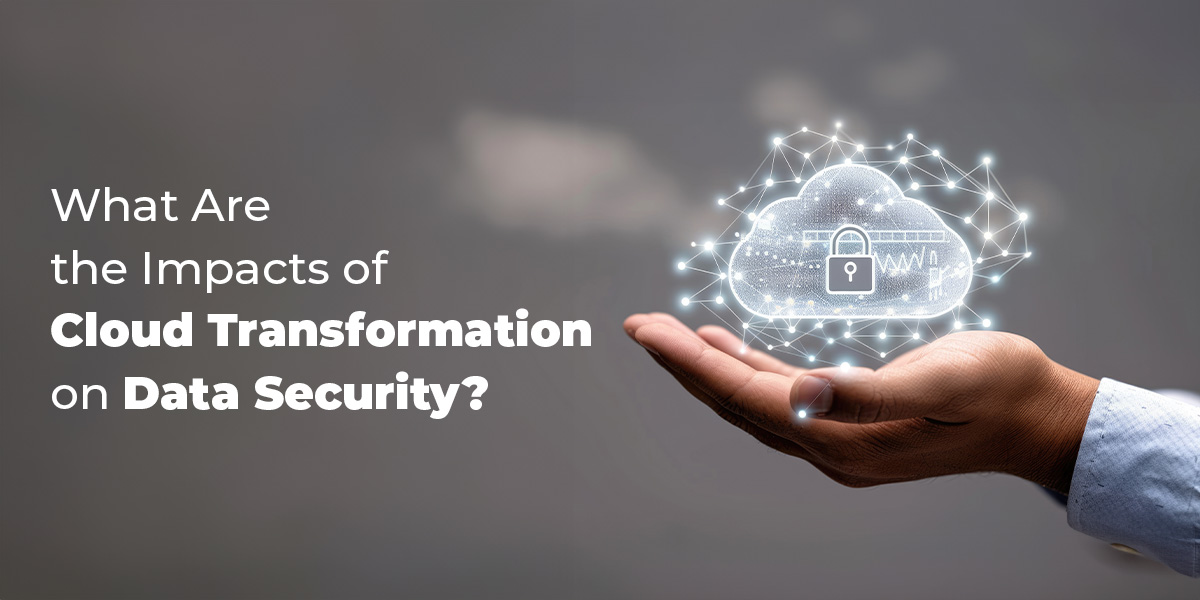
What are the Impacts of Cloud Transformation on Data Security?
- By Isa Willems
- 05-10-2024
- Cloud Computing
Many companies are finding that using the cloud helps them stay flexible and work better. When companies shift their data and applications to the cloud, they encounter both opportunities and challenges, particularly regarding data security. This blog looks at how moving to the cloud affects data security. It talks about the good and bad sides and gives tips on keeping important information safe
The Promise of Cloud Transformation
Cloud transformation means moving a company’s IT infrastructure, applications, and services from on-site setups to cloud-based platforms. This shift brings several benefits:
Scalability Flexibility
Cloud services allow businesses to customize their products based on demand. This flexibility helps companies adapt quickly to the market and their business needs. For example, during busy trading periods, retailers can easily increase their cloud capacity to handle more traffic without having to invest in sustainability, making the customer experience slowly
Cost efficiency
By reducing the need for physical hardware and on-site maintenance, companies can save on IT costs. Pay-as-you-go means that companies automatically use it, reducing capital costs and making budgets more predictable.
Accessibility and integration
Cloud platforms allow remote access to data and applications, facilitating collaboration spread between locations. This is especially useful in today’s remote work environment. Employees can access critical applications from anywhere, increasing productivity and supporting streamlined business processes.
Rapid innovation
Cloud services provide access to advanced technologies such as artificial intelligence, machine learning and big data analytics, which help businesses remain competitive and innovative Companies can experiment with new technologies and implement changes quickly with a system that and the passage of time does not stop them.
Understanding Data Security in the Cloud
While the cloud has many advantages, there are also challenges, especially in terms of data security. Companies need to address these issues to keep sensitive information secure. Here are some key points to consider.
Data privacy and compliance
It is important to comply with data protection regulations such as GDPR, HIPAA and CCPA when storing and processing data in the cloud. Companies need to know where their data is and how it’s being used to avoid legal and financial penalties. This means data governance, understanding the specific rules that apply in different regions.
Shared responsibility model
Security in the cloud is a shared responsibility between cloud providers and their customers. While cloud providers secure the infrastructure, customers must maintain access controls, data encryption, and other security aspects. Understanding this shared responsibility is essential to a comprehensive security strategy.
Data breaches and cyber threats
The cloud can be a target for cybercriminals looking to gain access to sensitive information. Organizations need to implement strong security measures to mitigate risks such as data breaches, malware attacks, and insider threats. This includes implementing advanced threat detection tools and maintaining a proactive cybersecurity approach.
Missing and available data
Ensuring data availability at all times and preventing loss is a major concern. Companies need to have data backup, disaster recovery and business continuity strategies in place to protect against disruptions. This includes choosing the right backup solution and testing it regularly to ensure that data can be restored quickly.
The Positive Impacts of Cloud Transformation on Data Security
When done thoughtfully and strategically, cloud transformation can significantly boost data security in several ways:
Advanced safety features
Cloud providers invest heavily in security, implementing advanced features such as encryption, identity, access management (IAM), security information and event management (SIEM) etc. These features help organizations strengthen their security. For example, Amazon Web Services (AWS) offers services such as AWS Key Management Service (KMS) to manage encryption keys, allowing users to manage their encryption
Automatic security updates
Cloud services often come with automatic security updates, ensuring that systems are protected against the latest threats. By reducing the workload on IT teams and reducing the risk of vulnerabilities, innovation itself can eliminate delays with known security flaws that are common targets in the case of cyber-attacks gone
Improved Data Redundancy and Backup
Cloud platforms provide strong data redundancy and backup options, helping businesses protect against data loss and ensure business continuity in the event of a disaster. For example, Azure Site Recovery allows organizations to replicate existing workloads to a new location, ensuring minimal downtime during downtime.
Improved analysis and analysis
Cloud services provide advanced analytics and analysis tools that provide real-time insights into network activity and potential threats. This visibility allows organizations to quickly identify and respond to security incidents. Tools like Google Cloud’s Security Command Center provide centralized visibility into an organization’s cloud assets, helping to identify system anomalies and vulnerabilities
The Challenges and Risks of Cloud Transformation on Data Security
Despite the benefits, cloud transformation also presents several challenges and risks that organizations must address:
Data governance and management
Moving data to the cloud makes it harder to manage and manage. Organizations need a clear data governance strategy to ensure data integrity and compliance. This means defining roles and responsibilities, developing data access policies, and ensuring data quality across the board.
Complex hybrid-multi-cloud environments
Many enterprises use multiple cloud providers, creating hybrid or multi-cloud systems. These challenges can lead to security gaps if not addressed properly. Enterprises need ways to manage and protect data across platforms, including consistent security measures and tools that span all environments.
Third party risk
Relying on third-party cloud providers comes with risks associated with vendor management and supply chain security. Organizations should thoroughly vet their vendors and create strong contracts to mitigate these risks. This includes examining vendor security practices, compliance certifications, and incident response capabilities.
Internal threats
Employees or employees working on cloud resources illegally can pose significant security risks. Implementing strict access policies and monitoring user activity is essential to prevent insider threats. Regular training and awareness programs can help reduce the risk of accidental data breaches caused by human error.
Best Practices for Securing Data in the Cloud
To get the most out of cloud transformation while keeping security risks in check, organizations should follow these best practices:
Data storage
Encrypt sensitive data when you store and send it to protect it from unauthorized access. Use strong encryption techniques and key management best practices to keep data confidential. Review and update your encryption policies regularly to prevent new threats.
Identity and Management (IAM) .
Establish a strong IAM policy to control who can access cloud resources. Use multifactor authentication (MFA) and role-based access control (RBAC) to restrict access to only those who need it. Review and update accessibility on a regular basis as roles and responsibilities change.
Regular safety audits and inspections
Conduct regular security audits and assessments to identify weaknesses and areas for improvement. Hire third-party experts to conduct penetration testing and vulnerability assessments. This analysis can provide valuable insights into potential vulnerabilities and help prioritize security investments.
Continuous monitoring and incident response
Develop comprehensive monitoring and incident response systems to rapidly identify and respond to security incidents. Use security information and event management (SIEM) tools to track cloud activity in real time. Create a clear incident response plan and implement it consistently to ensure you are prepared.
Data Loss Prevention (DLP) strategies
Use DLP techniques to protect against accidental or intentional data leaks. This includes managing data flow, enabling data governance policies, and educating employees on data security practices. DLP solutions can automatically identify and protect sensitive information, reducing the risk of a data breach.
Proper vendor management and inspection
Do thorough due diligence when choosing a cloud provider. Review their security practices, compliance certifications, and incident response capabilities to ensure they meet your organization’s security needs. Establish a clear service level agreement (SLA) that defines security expectations and responsibilities.
Training and awareness programs
Educate employees on cloud security best practices and the importance of protecting sensitive data. Regular training and awareness programs can help reduce the risk of human error and resultant threats. Promote a culture of safety awareness and accountability throughout the organization.
The Future of Cloud Transformation and Data Security
As more businesses move to the cloud, the way we handle data security will keep changing. A few trends and developments that are likely to shape the future of cloud transformation and data security are as follows:
Zero trust policy
The zero-trust security model, which focuses on verifying the authenticity of every user and device connected to the network, is becoming increasingly popular. This approach can improve security in cloud environments by reducing trust considerations and reducing attacks. Implementing uncertainty requires ongoing integrity and authorization along with rigorous monitoring and scrutiny.
Artificial intelligence and machine learning
AI and machine learning are increasingly being used to enhance cloud security. This technology can analyze large amounts of data to identify patterns and anomalies, vastly improving threat detection and action. Machine learning algorithms can adapt to new threats in real time, giving organizations a proactive security strategy.
Secure Access to Service Edge (SASE) .
SASE is an innovative cybersecurity paradigm that combines network security and wide area network (WAN) capabilities into a single cloud-based service. This approach can simplify security management and enhance protection for remotely distributed employees. The SASE solution integrates a variety of security services, such as secure web gateways, firewalls, and untrusted networks.
Technology that enhances privacy
With growing concerns about data privacy, technologies such as homogeneous encryption and secure multinational computing are gaining attention. This technology allows data to be processed and analyzed with privacy intact. Organizations can use these tools to analyze data without divulging any sensitive information.
Increased focus on compliance and regulatory requirements
As data protection laws evolve, organizations need to stay compliant. This means adapting to new rules and being transparent about data handling practices. Companies should invest in compliance management solutions that automate the monitoring and reporting of regulatory requirements.
Utilizing Expertise in Cloud Transformation
Successfully managing the complexity of the cloud transition and ensuring data security can be a daunting task. This is where teaming up with experts who truly understand the cloud environment can make all the difference. Their expertise helps companies maximize the benefits of cloud adoption while minimizing risk.
For example, specialists in cloud transformation can provide tailored strategies that meet unique business needs from implementing strong security measures to ensuring compliance with data protection regulations Enterprises if they have in-depth expertise in cloud services provide valuable support to optimize cloud infrastructure for business and flexibility. Their approach helps businesses confidently embrace cloud transformation, protect their data, and increase operational agility.
These experts can also help select the right cloud providers and solutions that align with the company’s strategic goals, ensuring that cloud technologies are seamlessly integrated into existing systems If their experience is a leveraged role, businesses can avoid common pitfalls and ensure a smooth transition to the cloud. In addition, these professionals can provide ongoing support and training to internal teams, contributing to a culture of continuous improvement and innovation. By leveraging the knowledge of such experience, companies can confidently navigate the dynamics of cloud security and change. Smart techniques and new technologies can be used to create a secure, efficient, and creative cloud infrastructure that meets your goals.
Conclusion
The cloud isn’t just a futuristic idea anymore; it’s now a fundamental part of modern business operations. It offers clear benefits like scalability, work efficiency, and encouraging new ideas. But it also is not that efficient when it comes to keeping sensitive data safe. As we’ve discussed, the cloud brings a complex security landscape that requires a thoughtful and strategic approach.
While the risks are real, they shouldn’t overshadow the immense opportunities. When used in the right manner, the cloud can be a great way to keep data safe. By understanding the shared responsibility model, investing in strong security measures, and fostering a culture of data security, organizations can mitigate risks and fully leverage the cloud’s potential.
For cloud transformation to work well, companies need to balance new ideas with security. They need to stay ahead of threats and make data security a big part of their cloud plans. This way, they can protect their important information and stay competitive. When done right, the cloud can help companies be more secure, flexible, and successful
Partnering with experts can make the journey through cloud transformation much smoother. Their customized strategies can boost your data security and operational agility, setting you up for a secure and innovative future.
Recent blog

The Role of Mobile Apps in Modern School Management Systems
Mobile Apps | 15-09-2025.jpg)
Why Specialized Ecommerce SEO Companies Scale Growth Faster?
SEO | 12-09-2025.jpg)




